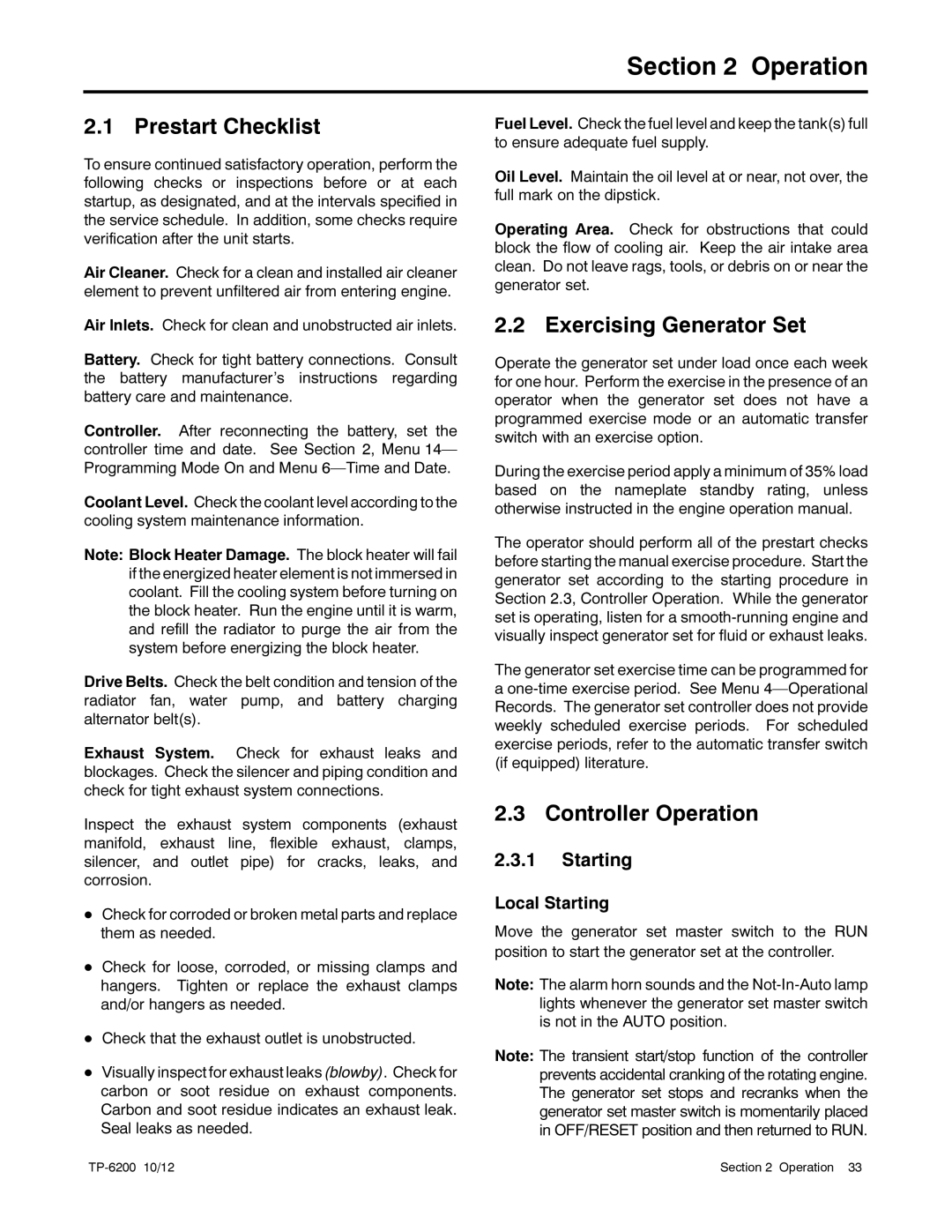Section 2 Operation
2.1 Prestart Checklist
To ensure continued satisfactory operation, perform the following checks or inspections before or at each startup, as designated, and at the intervals specified in the service schedule. In addition, some checks require verification after the unit starts.
Air Cleaner. Check for a clean and installed air cleaner element to prevent unfiltered air from entering engine.
Air Inlets. Check for clean and unobstructed air inlets.
Battery. Check for tight battery connections. Consult the battery manufacturer’s instructions regarding battery care and maintenance.
Controller. After reconnecting the battery, set the controller time and date. See Section 2, Menu 14— Programming Mode On and Menu
Coolant Level. Check the coolant level according to the cooling system maintenance information.
Note: Block Heater Damage. The block heater will fail if the energized heater element is not immersed in coolant. Fill the cooling system before turning on the block heater. Run the engine until it is warm, and refill the radiator to purge the air from the system before energizing the block heater.
Drive Belts. Check the belt condition and tension of the radiator fan, water pump, and battery charging alternator belt(s).
Exhaust System. Check for exhaust leaks and blockages. Check the silencer and piping condition and check for tight exhaust system connections.
Inspect the exhaust system components (exhaust manifold, exhaust line, flexible exhaust, clamps, silencer, and outlet pipe) for cracks, leaks, and corrosion.
DCheck for corroded or broken metal parts and replace them as needed.
DCheck for loose, corroded, or missing clamps and hangers. Tighten or replace the exhaust clamps and/or hangers as needed.
DCheck that the exhaust outlet is unobstructed.
DVisually inspect for exhaust leaks (blowby). Check for carbon or soot residue on exhaust components. Carbon and soot residue indicates an exhaust leak. Seal leaks as needed.
Fuel Level. Check the fuel level and keep the tank(s) full to ensure adequate fuel supply.
Oil Level. Maintain the oil level at or near, not over, the full mark on the dipstick.
Operating Area. Check for obstructions that could block the flow of cooling air. Keep the air intake area clean. Do not leave rags, tools, or debris on or near the generator set.
2.2 Exercising Generator Set
Operate the generator set under load once each week for one hour. Perform the exercise in the presence of an operator when the generator set does not have a programmed exercise mode or an automatic transfer switch with an exercise option.
During the exercise period apply a minimum of 35% load based on the nameplate standby rating, unless otherwise instructed in the engine operation manual.
The operator should perform all of the prestart checks before starting the manual exercise procedure. Start the generator set according to the starting procedure in Section 2.3, Controller Operation. While the generator set is operating, listen for a
The generator set exercise time can be programmed for a
2.3 Controller Operation
2.3.1Starting
Local Starting
Move the generator set master switch to the RUN position to start the generator set at the controller.
Note: The alarm horn sounds and the
Note: The transient start/stop function of the controller prevents accidental cranking of the rotating engine. The generator set stops and recranks when the generator set master switch is momentarily placed in OFF/RESET position and then returned to RUN.
Section 2 Operation 33 |
